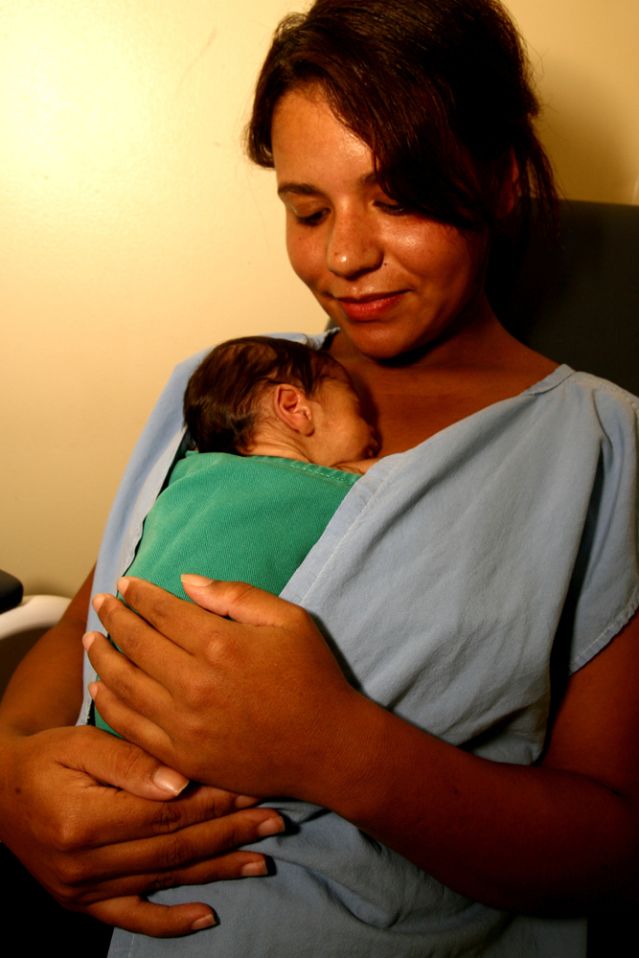
Source: Joa Souza / Shutterstock
Outcomes for America’s newborns are the worst among the 38 OECD countries, including Canada and most of Western Europe. In particular, the almost 40 percent of infants in America who are born before reaching full term are at increased risk of early death, disease, and disabilities throughout their lives—and this situation continues to worsen. Among Black and Native American children, the mortality rate is double that of white infants.
The Age-Old Solution That Saves Lives
However, there is a scientifically proven, low-cost method that can effectively address this tragedy: prolonged skin-to-skin contact between parents and infants, immediately after birth. This technique, often referred to as kangaroo mother care (KMC), saves more lives than incubators while improving long-term health outcomes, according to researchers—even for extremely premature infants.
For much of human history, skin-to-skin care for infants was a default behavior. Our modern adoption of other methods, and particularly the use of incubators, is a story of too much of a good thing.
How Technology Took Over
Incubators were developed in the late 19th century in France, where a doctor battling high infant mortality designed them (based on chicken incubators) to assist mothers and nurses caring for infants with low birth weight. Subsequent American versions of incubators, sometimes billed as “artificial wombs,” included new innovations, like oxygen and feeding tubes. Medical professionals often used these devices to replace maternal care.
Incubators became the standard of care for preterm infants after WWII, saving the lives of many fragile infants, but sometimes playing a role in causing tragic, lifelong morbidities. Around this time, medical professionals took over the care of premies completely. While the practice of isolating newborns from their parents peaked and began to decline in the late 1980s, parental access to preterm infants remains limited.
The Scientific Case for KMC
Even as hospital births and the separation of newborns from mothers became standard, a different group of researchers were reporting findings that contraindicated this practice. Scientists discovered that all newborn mammals require species-specific contact with their mothers’ bodies and microbiomes to survive and thrive.
In 1978, a lack of reliable electricity in Bogota, Colombia, led to one of the first (albeit impromptu) large-scale trials of KMC. Faced with unreliable incubators and high infant mortality, local physicians revived the traditional Colombian practice of warming babies with skin-to-skin contact and replaced scheduled formula feeding with breastfeeding on demand, continuing for about 30 days (until the baby was normal weight). Mothers and fathers took shifts, sleeping propped up on pillows with the baby strapped on their chests. The results were striking: infant mortality dropped precipitously.
Decades of global research has since confirmed these results. A 2023 meta-analysis concluded that when premature infants are provided with skin-to-skin care, they have improved breastfeeding, weight gain and sleep compared with infants given incubator care alone. Infants given KMC also had improved cardiac, hormone, thermoregulation, metabolic, and immune systems function. Even delaying skin-to-skin contact to ‘stabilize’ premature babies caused such an increase in their deaths that research comparing immediate and delayed KMC had to be halted.
Since, like a kangaroo’s pouch, skin-to-skin care fosters the development of immature systems after birth, the World Health Organization (WHO) calls it Kangaroo Mother Care. In 2022, the WHO changed its standard of care for all preterm, stressed, and low birth-weight infants to kangaroo care for 8-to-24 hours per day, starting immediately after birth.
The Social Benefits of Kangaroo Care
In addition to its medical benefits, KMC promotes parent-child bonding. It increases parents’ confidence and their abilities to parent effectively, as well as improving babies’ social abilities. A recent study of extremely premature (28-33 week gestational age) infants in Sweden and Norway found that KMC in the six hours immediately following birth significantly improved mother-child relationships and communication four months later.
The advantages of KMC last a lifetime. Dr. Ruth Feldman, Simms/Mann professor of social neuroscience and director of the Center for Developmental Social Neuroscience at Reichman University, and her associates demonstrated that KMC tunes our social brains. Compared with their peers who received incubator care, babies who received KMC immediately after birth had closer relationships and were more resilient throughout childhood and adulthood.
As a mental health professional, I spent decades working with patients to mitigate the damage suffered from an inability to bond during the critical hours and days after birth, due, at least in part, to the impact of well-intentioned interventions that separate infants and parents. Reliance on devices like incubators blinds us to the life-long cost of separating infants and parents, and to the lifesaving opportunity that reinforcing their bond provides.
Updating Our Standard of Care
Of course, incubators can be a life-preserving technology and remain vital for extremely fragile infants who are unable to breathe spontaneously after resuscitation, are in shock, or need mechanical ventilation. However, incubators are consistently overused. The U.S. standard of care and default treatment is still to place preterm and low birth-weight infants in NICU incubators, though leading hospitals encourage parents to provide KMC as an optional supplement. This is partially because highly trained professionals whose education, career, liability concerns, and financial interests, combined with faith in technological solutions, find it difficult to believe that parents can provide better care.
To implement its guidelines, the WHO recommends that national governments provide paid parental leave, that they recognize, finance, and promote KMC as essential care, and that hospitals provide parental coaching and treat mother and infant as an inseparable unit.
The U.S. falls short on all of these recommendations. Every government health agency should educate parents, the public, insurers, and medical providers about the urgency of following WHO kangaroo care guidelines.
The lives and long-term health of over a million American premature and early-term infants are at stake every year. We should give every baby the best possible chance to bond, survive, and thrive.

